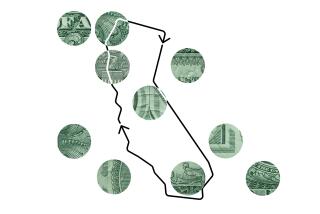Smoker Group’s Thick Wallet Raises Questions
- Share via
The country’s leading smokers’ rights group has built a fat war chest despite minimal support from the 3 million people it claims as members, according to public records and internal documents that suggest its only significant backer is Big Tobacco.
The National Smokers Alliance has become a major force in public smoking battles in California and elsewhere, while portraying itself as “a nonprofit, grass-roots membership organization with more than 3 million members.” That claim in the group’s brochures also appears regularly in stories on the Alexandria, Va.-based group by major news organizations.
But a review of the group’s annual reports to the Internal Revenue Service shows that a tiny fraction of the putative members pay the nominal $10 dues the group says it charges. According to the IRS reports, of the $45.9 million amassed by the group in its first three years, very little came from dues.
In fiscal 1996, for example, when total receipts were more than $9 million, dues contributed just under $74,000. In other words, the group collected enough dues for 7,400 members.
*
By contrast, support from tobacco companies, while not disclosed in public reports, has been generous. Internal documents reviewed by The Times show that of the first $7 million funneled to the alliance after its founding in August 1993, nearly all came from giant Philip Morris Cos. More recent internal documents were not available.
Whether the alliance has any significant funding beyond industry contributions is an issue its officials won’t discuss. Gary Auxier, the group’s senior vice president and chief spokesman, refused to discuss its finances, saying, “I really don’t want to entertain your questions.”
In the past, Auxier and other officials have said that seed money to start the alliance came from Philip Morris and that it has since been supported by membership dues and corporate contributions, including from tobacco firms. But they have refused to discuss how much the group relies on cigarette makers--saying only that they should give more because the alliance speaks for their customers.
The group’s failure to develop a grass-roots financial base reflects the ambivalence of most smokers toward curbs on the right to smoke.
*
Facing increasing hostility from nonsmokers, as well as mounting restrictions on where they can light up, the nation’s 48 million smokers would appear to be a potent political force. But experts say a large majority of smokers want to quit, and rather than fighting back tend to regard bans as the medicine they need.
Many smokers “fully believe in the health issues and . . . actually like the imposed assistance” of smoking bans, said Dee Burton, an associate professor of public health at the University of Illinois-Chicago who has extensively researched the attitudes of smokers.
Even the roughly 20% of “committed smokers”--those not intending to quit--don’t want their children to smoke and don’t identify with the industry, Burton said.
“Even though one may want to continue smoking . . . there’s still no desire really to align oneself with an industry that’s seen as going after children,” Burton said.
The bottom line: “You just can’t find that many people who say smoking’s a great thing and let’s get involved in a movement,” she said.
In many prominent battles, however, the smokers’ alliance has put itself forward as the voice of abused smokers rather than as a mouthpiece for the industry.
*
The group was launched by Philip Morris and Burson-Marsteller, the tobacco giant’s longtime public relations firm. The two directors named in its incorporation papers were both lawyers with Hunton & Williams, a Richmond, Va., law firm that represents Philip Morris. The alliance’s interim president, David K. McCloud, was a Burson-Marsteller executive.
McCloud was succeeded by Thomas Humber, a fellow Burson executive who had worked for Philip Morris in Switzerland and earlier for Brown & Williamson Tobacco Corp.
Humber earned $450,731 as president and CEO of the alliance during the year ended Sept. 30, 1996, according to the group’s report to the IRS.
As a tax-exempt organization, the alliance must report annual financial data to the IRS, disclosing among other things the salaries of top officers, the names of corporate donors and how much they give.
But contributor information is deleted, on privacy grounds, when copies of the reports are provided by request to the public or the media.
However, the redacted reports do state how much of a group’s money comes from “membership dues and assessments.” During the last two reporting years, dues accounted for less than 1% of the group’s receipts.
Moreover, internal documents show that of the first $4 million received by the group through early 1994, 96% came from Philip Morris alone. By the middle of that year, the company had given $3 million more, one of the documents states.
By then the alliance had launched membership drives to develop an independent base, but with disappointing results. After expensive mass mailings brought little response, the group began paying recruiters to sign up members in bars, bowling alleys and other places where smokers congregate, according to interviews and published reports.
The alliance has also tapped political figures and celebrities to serve as directors and on its board of advisors to add luster to its image. Jeanie R. Austin, former co-chairwoman of the Republican National Committee, is a director.
But the use of celebrity spokesmen backfired in at least one case: former board of advisors member Morton Downey Jr.
The acerbic talk show host, a heavy smoker, left the board of advisors in 1996. Within weeks of resigning, he was diagnosed with lung cancer. At a press conference soon thereafter, Downey committed himself to the anti-smoking cause and attacked the alliance as a “total front” for the industry--a charge a spokesman denied.
More to Read
Sign up for Essential California
The most important California stories and recommendations in your inbox every morning.
You may occasionally receive promotional content from the Los Angeles Times.













